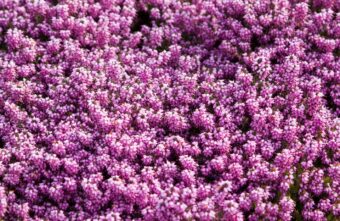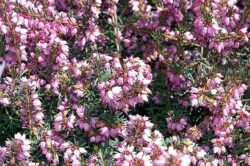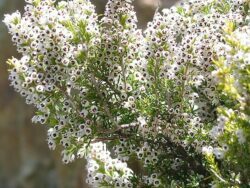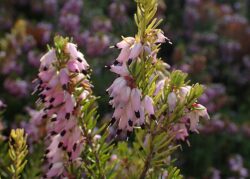In this article, we will discuss how to grow Heath or Ericas in containers. They not only look beautiful but they can be used to give a home to wildlife, especially bees when little is in bloom. They not only flower but offer permanent greenery when colours will be most appreciated. There is a great variation in foliage forms and in the colour of the flowers. Some even have a scent so what is not to like about these shrubs, as they bring so much colour in winter then it is hard to beat.

Ericas like its cousins Calluna (the Scottish Heathers) prefers to be grown in a sunny location, but they can take some shade but not a lot.
You do have plenty of choice as to what species and varieties that you can grow from Erica carnea and Erica x darleyensis that flower in winter and spring respectively. For summer you can grow Erica vagans.
THEY ARE WIDELY AVAILABLE
The good thing is that Ericas is more widely available from garden centres to online shops, where often they sold as a year old plant. These are adequate but it is better to go got larger 2 to 3 old specimens as they have more oomph for the price. Larger plants mean a better show. It is well known that heathers like the soil to be acidic but it may surprise people that Ericas do not need to be as acids as you first thought.
Erica carnea, Erica x darleyensis and Erica vagans will tolerate heavier soil and will take PHs of 7 or higher, as long as there is plenty of organic material present as possible. This means that you do not necessarily have to use ericaceous composts but it is advised to continue to use them, as it will give a better growing media. What is an ideal mixture is to use ericaceous compost and mix a spadeful of farmyard manure with it.
PLANTING ERICA IN CONTAINERS
You can use a 40cm diameter pot unto which the plant will be planted in. Fill the pot with a mixture of 70% by volume of ericaceous compost, 10% farmyard mature and 20% horticultural grit to improve drainage.

Dig a hole twice the size of the root ball and place the plant at the same level it came in the original pot. Backfill will more growing media and firm the plant in, filling any gaps with more growing media, Water well with rainwater and let it settle in. You will need to continue to water for at least a year at regular intervals until it is well established.
You will need to water frequently when there is a heatwave is forecasted. The growing media must be moist but the plant will not tolerate being soggy at all.
Heath in containers will need to be fed as the leaves can turn yellow. If this does occur in early spring, feed with an ericaceous slow-release fertiliser. Newly planted specimens will not need to be fed until after a couple of months but are best in this case to start a monthly feed of a liquid-based ericaceous fertilizer.
PRUNING
Ericas need little in the way of pruning but by the trimming if fading flowering stems back to bases straight after flowering. Do not cut back to old wood as this will ruin the plant. It will not grow from old wood and after a while, it will become leggy. In this case, you will need to replace the whole plant.
It is best to do this by semi-ripe cutting in July or august or by layering in spring.
Heaths can suffer from root rot in warmer climates, so it is best to improve drainage by growing it in the recommended growing media. They do not suffer from pests or diseases, but rabbits and deers will eat them if they have the chance.
TREE HEATHERS
Tree heathers are attractive shrubs that flower in spring and can grow up to 4m in height. The flowers are liked by wildlife and they will tolerate pruning well.

Erica arborea is the most common one, where it can really make a good summer show. For the first three years, you can prune it back by a third to half to develop the plant, After this, little is required in the way of pruning, It will recover very well, even if it is cut to old wood.
Other tree heather types include E. lusitanica that will grow in acidic, native soil, E. x veitchii that will grow in native soil and E. australis that like ericaceous soil. They all need minimal pruning.
VARIETIES TO GROW
Erica carnea ‘Myratoun Ruby’ has dark green leaves and is covered with rose-pink flowers in winter.
Erica carnea ‘Springwood White’ has mid to dark green leaves and is covered with white winter blossoms.

There is also Erica carnea ‘Foxhollow’ has yellow-green young foliage that turns red-orange in winter. It has a mass of pale pink/purple flowers.
A taller variety of Erica is Erica x darleyensis ‘Ghost Hills’ that has vivid green leaves that are covered in white, creamy flowers that are tipped purple.
Erica lusitanica ‘George Hunt’ has vibrant yellow-green leaves and on top of this scented, white flowers appear in spring. Grows up to 1.3m in height.
Erica arborea ‘Alpine’ is a 2m shrub that has vivid, green leaves that are covered with small, fragrant white flowers.
Erica cinerea ‘Pink Ice’ is a summer-flowering species of Erica that has dark green leaves and flowers that are light pink in colour. Only grows up to 20cm in height.
CONCLUSIONS
In this article, we have discovered how to grow Ericas in containers including tree heathers. As you can see they are not difficult to grow, as long as you are prepared to feed them occasionally m water them and prune them after they have flowered. A plant that will bring colour and joy to a dull period of time where little is in flower. Ericas are such delightful plants so why not grow one today.
If you have any comments or questions that you wish to make on growing Ericas in containers, please do so in the comment box below,
Happy Erica growing.
